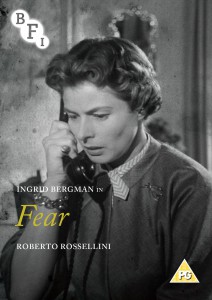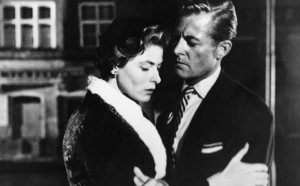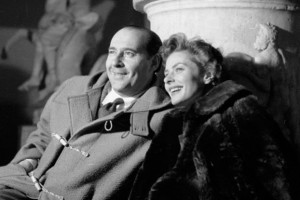
Written by Sergio Amidei and Franz von Treuberg
Directed by Roberto Rossellini
German/Italy, 1954
The moral furor that erupted when Roberto Rossellini and Ingrid Bergman began their much-condemned affair in 1950 did not, thankfully, hinder their productivity or their creativity. Despite the outrage, the two embarked on a cinematic collaboration that produced a series of excellent films in a relatively short period of time. While their marriage lasted until 1957, their final feature together was Fear (1954), out now on a new DVD from the British Film Institute. Though the film’s home video release is a welcome one—any Rossellini film made available is a good thing—the film itself pales in comparison to their earlier efforts.
Just as he had on many of his brother’s films, Renzo Rossellini provides the score, which here is instantly redolent with the sounds of a thriller. The opening likewise looks as if it’s a standard film noir, with a menacing city at night and headlights piercing through the at times barely visible surroundings. Fear begins with two different confrontations. Though left somewhat vague in terms of complete detail, trouble is evident right away as Irene Wagner (Bergman) and Erich Baumann (Kurt Kreuger) meet under what are clearly unnerving circumstances. Their relationship seems to be at an end, yet it remains passionate even in its dissolution, hinting at the love that once was and still may be. Not long after that, further tension is added in what is also noirish fashion, as Luisa Vidor, AKA Johann Schultze (Renate Mannhardt), emerges ominously from the shadows outside Irene’s home. She accosts Irene, who does her best to abolish the young woman by throwing some money at her, presuming her to be a beggar. Irene then enters her house where she encounters her husband, Professor Albert Wagner (Mathias Wieman), who is still awake working. So she is married … the plot thickens. The next day, Luisa shows up to the laboratory where Irene and Albert work (so much seemingly unnecessary attention is given to the poison he is toiling with that it can’t help but reemerge). Luisa, who turns out to be Erich’s jaded ex-lover, is aware of Irene’s affair. As she demands more money to keep quiet, the inescapable blackmail begins. Soon she is following Irene with a harassing insistence.
 Everything is essentially set up by this point: Fear is to be a story of secrets and lies within a gradually evolving web of deceit, which is itself melodramatically merged together in a suspenseful fusion. The problem is most of these narrative checkpoints are not particularly unique, and for much of the film, Fear displays little of the hallmarks that distinguish Rossellini’s better productions. There is, in the end, little to distinguish the film at all.
Everything is essentially set up by this point: Fear is to be a story of secrets and lies within a gradually evolving web of deceit, which is itself melodramatically merged together in a suspenseful fusion. The problem is most of these narrative checkpoints are not particularly unique, and for much of the film, Fear displays little of the hallmarks that distinguish Rossellini’s better productions. There is, in the end, little to distinguish the film at all.
The other features Rossellini made with Bergman—especially the big three of Stromboli (1950), Europa ’51 (1952) and their best collaboration, Journey to Italy (1954)—all bore something exceptional, if not in their literal, superficial plot, than in their emotional weight, their complex themes, and their contemplative, existential tone. Some of this introspection is seen in Fear, by way of Bergman’s despair and dire confusion; she is exhausted, in a state of panic, and obviously at a crucial crossroads in her life. And it must be said that her performance does get better toward the end of the film, as her past and her now threatening present collide. Yet even with the twist near the film’s conclusion, which leaves us to question the motivations of several involved, certain sections of the film come on overly strong in their obvious attempts to instill various scenes with the underlying subject of the film, principally honesty. “Everyone in our house is honest,” says Albert after he discovers their daughter stole from their son. He and Irene then discuss the girl’s lack of courage to admit she did something wrong. Irene wonders if maybe she was ashamed. “I don’t want you to think I don’t know how to forgive,” reassures Albert. It’s so blatant that the theft is not the true topic under discussion that it all becomes a little heavy handed. Having seen the sublime subtlety of his prior works with Bergman, we know Rossellini can do better than this.
 Though the reveal at the end is admittedly somewhat surprising, the real question is, does it do enough to make what had transpired more interesting, or, most importantly, does it elevate the film as a whole? While it contributes to the former, it does not result in the latter. By the time it’s all over, we feel the wrong person is happy, the wrong person is sad, the wrong one relieved, and the wrong one guilt-ridden. The film’s conclusion, as Tag Gallagher puts it, leaves moral conflicts “glaringly unresolved.”
Though the reveal at the end is admittedly somewhat surprising, the real question is, does it do enough to make what had transpired more interesting, or, most importantly, does it elevate the film as a whole? While it contributes to the former, it does not result in the latter. By the time it’s all over, we feel the wrong person is happy, the wrong person is sad, the wrong one relieved, and the wrong one guilt-ridden. The film’s conclusion, as Tag Gallagher puts it, leaves moral conflicts “glaringly unresolved.”
There are also errors in terms of practical detail, as when a scene begins while Bergman sits in her car: there is a brief beat while she is immobile for no apparent reason (presumably waiting for a call to “action”), then she suddenly drives forward, only to come to a stop a few feet away. This jerky type of discontinuity is not unheard of for Rossellini. In fact, there are several similar examples in his neorealist masterworks. But in their defense, Rossellini’s filmmaking methods and production capacities then were far different than they were by 1954, and one could even argue that such lapses in editorial smoothness worked in the service of his quest for an unaltered, unbridled realism. With Fear, it sometimes just seems sloppy.
Where Fear does stand out is in its imagery, thanks chiefly to the versatile cinematographer Carlo Carlini, here working with the German Heinz Schnackertz. From the opening night in the city to the sequences in the tranquil countryside, there are few moments when the film doesn’t at least look impressive. There are times, too, when Rossellini integrates some unexpected camera movement, giving the film a few brief, though notable, bursts of stylistic vitality.

Fear is an excellent example of a filmmaker done in by their prior, far superior work. Rightly or wrongly, it’s difficult not to judge the film based on what we know Rossellini and Bergman could accomplish, and fortunately, better films were still to follow for both, even as they went their separate ways. So while Fear is worth taking a look at, it is not representative of the best the two had to offer, and it generally exists as work primarily for Rossellini or Bergman completists.

